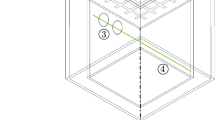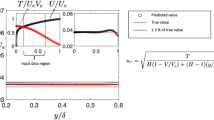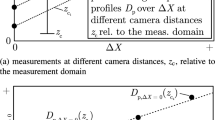Abstract
Physical interpretations and especially analytical considerations benefit from the ability to accurately estimate derivatives of experimentally measured statistical profiles. Toward this aim, experiments were conducted to investigate the efficacy of single-component molecular tagging velocimetry (1c-MTV) to measure mean velocity profiles that can be differentiated multiple times. Critical effects here pertain to finite measurement uncertainty in the presence of high spatial resolution. Measurements acquired in fully developed turbulent channel flow over a friction Reynolds number range from 390 to 1800 are used to investigate these issues. Each measured profile contains about 880 equally spaced data points that span from near the edge of the viscous sublayer to the channel centreline. As a result of the high spatial resolution, even very small levels of uncertainty in the data adversely affect the capacity to produce smooth velocity derivative profiles. It is demonstrated that the present 1c-MTV measurements can be differentiated twice, with the resulting profile remaining smooth and accurate. The experimental mean velocity profiles and their wall-normal derivatives up to second order are shown to convincingly agree with existing DNS data, including the apparent variations with Reynolds number.
Similar content being viewed by others
References
Bohl D (2002) Experimental study of the 2-D and 3-D structure of a concentrated line vortex. PhD thesis, Michigan State University, East Lansing
Bohl D, Koochesfahani M (2009) MTV measurements of the vortical field in the wake of an airfoil pitching at high reduced frequency. J Fluid Mech 620:63–88
Caso M, Bohl D (2014) Error reduction in molecular tagging velocimetry via image preprocessing. Exp Fluids 55:1802–1811
Dean RB (1978) Reynolds number dependence of skin friction and other bulk flow variables in two-dimensional rectangular duct flow. J Fluid Eng 100:215–223
Elsnab J, Maynes D, Klewicki J, Ameel T (2010) Mean flow structure in high aspect ratio microchannel flows. Exp Therm Fluid Sci 34:1077–1988
Elsnab J, Klewicki J, Maynes D, Ameel T (2011) Mean dynamics of transitional channel flow. J Fluid Mech 678:451–481
Gendrich CP, Koochesfahani MM (1996) A spatial correlation technique for estimating velocity fields using molecular tagging velocimetry (MTV). Exp Fluids 22:67–77
Gendrich CP, Koochesfahani MM, Nocera DG (1997) Molecular tagging velocimetry and other novel applications of a new phosphorescent suparmolecule. Exp Fluids 23:361–372
Hill RB, Klewicki JC (1996) Data reduction methods for flow tagging velocity measurements. Exp Fluids 20:142–152
Hoyas S, Jimenez J (2006) Scaling the velocity fluctuations in turbulent channels up to Re\(_\tau =2003\). Phys Fluids 18(011):702
Hu H, Koochesfahani M (2011) Thermal effects on the wake of a heater circular cylinder operating in mixed convection regime. J Fluid Mech 685:235–270
Hyland RW, Wexler A (1980) Formulations for the thermodynamic properties of the saturated phases of \({H}_2{O}\) from 173.15 K to 473.15 K. Tech. Rep. RP 216, Part 1, ASHRAE
Johansson A, Alfredsson P (1982) Effects of imperfect spatial resolution on measurements of wall-bounded turbulent shear flows. J Fluid Mech 122:295–314
Klewicki J, Falco R (1990) On accurately measuring statistics associated with small-scale structure in turbulent boundary layers using hot wire probes. J Fluid Mech 219:119
Klewicki J, Hill R (1998) Spatial structure of negative \(\partial \tilde{u}/\partial y\) in a low R\(\theta\) turbulent boundary layer. J Fluid Eng 120:772–777
Klewicki J, Fife P, Wei T, McMurtry P (2007) A physical model of the turbulent boundary layer consonant with mean momentum balance structure. Philos Trans R Soc A 365:823–839
Koochesfahani M, Cohn R, Gendrich C, Nocera D (1997) molecular tagging diagnostics for the study of kinematics and mixing in liquid phase flows. Chapter 2, Section 1. Developments in laser techniques and fluid mechanics. Springer, Berlin
Koochesfahani M, Cohn R, MacKinnon C (2000) Simultaneous whole-field measurements of velocity and concentration fields using combination of MTV and LIF. Meas Sci Technol 11:1289–1300
Koochesfahani M, Nocera DG (2007) Molecular tagging velocimetry. In: Tropea C, Yarin AL, Foss JF (eds) Handbook of experimental fluid dynamics, Chap 5. Springer, Berlin, Heidelberg, pp 362–382
Kwon Y, Philip J, de Silva CM, Hutchins N, Monty J (2014) The quiescent core of turbulent channel flow. J Fluid Mech 751:2228–254
Lee J, Kevin Monty J, Hutchins N (2016) Validating under-resolved turbulence intensities for PIV experiments in canonical wall-bounded turbulence. Exp Fluids 57:129–140
Moffat RJ (1988) Describing the uncertainties in experimental results. Exp Therm Fluid Sci 1:3–17
Monty J (2005) Developments in smooth wall turbulent duct flows. PhD thesis, The University of Melbourne, Australia
Monty J, Chong M (2009) Turbulent channel flow: comparison of streamwise velocity data from experiments and direct numerical simulation. J Fluid Mech 633:461–474
Moser RB, Kim J, Mansour NN (1999) Direct numerical simulation of turbulent channel flow up to \({Re_\tau =590}\). Phys Fluids 11(4):943–945
Nagashima A (1977) Viscosity of water substances—new international formulation and its background. J Phys Chem Ref Data 6:1133–1166
Olson D, Katz A, Koochesfahani M, Rizzetta D, Visbal M (2013) On the challenges in experimental characterization of flow separation over airfoils at low Reynolds number. Exp Fluids 54:1470–1481
Olson D, Naguib A, Koochesfahani M (2015) Measurement of the wall pressure and shear stress distribution using molecular tagging velocimetry. Exp Fluids 56:171–177
Pouya S, Liu D, Koochesfahani M (2015) Effect of finite sampling time on estimation of Brownian fluctuation. J Fluid Mech 767:65–84
Ramsey M, Pitz R (2011) Template matching for improved accuracy in molecular tagging velocimetry. Exp Fluids 51:811–819
Sadr R, Klewicki JC (2003) An experimental investigation of the near-field flow development in coaxial jets. Phys Fluids 15(5):1233–1246
Savitzky A, Golay MJ (1964) Smoothing and differentiation of data by simplified least squares procedures. Anal Chem 36(8):1627–1639
Smits A, Monty J, Hultmark M, Bailey S, Hutchins N, Marusic I (2011) Spatial resolution correction for wall-bounded turbulence measurements. J Fluid Mech 676:41–52
Sreenivasan KR (1989) The turbulent boundary layer. In: Gad-el-Hak M (ed) Frontiers in experimental fluid mechanics, vol 46. Springer, Berlin, pp 159–209
Thurlow EM, Klewicki JC (2000) Experimental study of turbulent Poiseuille–Couette flow. Phys Fluids 12(4):865–875
Wei T, Fife P, Klewicki JC, McMurtry P (2005) Properties of the mean momentum balance in turbulent boundary layer, pipe and channel flows. J Fluid Mech 522:303–327
Acknowledgements
This study was supported by Australian Research Council Grant numbers DP120101467 and LE130100088. The authors also thank Dr. Hoyas, Dr. Jimenez, Dr. Kim, Dr. Mansour, and Dr. Moser for making their DNS data available.
Author information
Authors and Affiliations
Corresponding author
Appendix
Appendix
1.1 Required resolution and displacement accuracy
Overall, the accuracy of the profiles of the terms in the mean momentum equation (or any other mean equation that has derivatives) depends upon the flow situation. In the present study, the mean equation for the canonical flow is examined. In a flow that is perturbed from the canonical state, the nature of the perturbations will generate features in the instantaneous dynamics that impart their signature on the mean profile. Reasonably then, one needs the capacity to resolve these features. Thus, as a general operational rule, measurements must capture derivatives over only a few viscous lengths. This is why we sought to generate profiles containing over 850 data points each, as this will provide the desired resolution, essentially independent of perturbation, over the given Reynolds number range of the facility.
More generally, to quantify the spatial resolution required to obtain accurate derivatives, one can differentiate the data using various step sizes (\(\Delta y^+\)). For \(\delta ^+=955\), the step size varied from 1 to 4 viscous units in the wall-normal direction and at \(\delta ^+=1800\), \(\Delta y^+\) was varied between 2 and 8. The data shown in Fig. 12 for both \(\delta ^+=955,\,1800\) indicate that if \(\Delta y^+>2\), the accuracy of the derivatives diminishes in the near-wall region. However, for \(y^+ > 100\), the deviation is not pronounced and increasing the step size can smooth the data. In the outer layer, the increase in step size is acting as a filter. As \(y^+ \rightarrow \delta ^+\), the gradient approaches zero; therefore, any error in the velocity introduces noise that propagates when determining the Reynolds stress and subsequent gradients.
Not surprisingly, the requisite spatial resolution is a function of wall-normal position. This is made apparent by the resolutions employed in DNS. At \(y^+=10,\, \delta ^+=934\), the spacing is about 1 viscous unit, but increases to \(\Delta y^+=3.3\) at \(y^+=100\). At \(\delta ^+=2004\), the spacing is 1.5 viscous units at \(y^+=10\) and 4 at \(y^+=100\). The experimental data are at these resolutions in the near-wall region (1 and 2 viscous units for \(\delta ^+=955\) and 1800) and are constant across the channel half-height. From Fig. 12, when \(\Delta y^+\) exceeds that of the DNS, the first derivative loses accuracy. Therefore, the spatial resolution significantly impacts the first derivative, especially for \(y^+<100\). Based upon the experimental results and the wall-normal spacing of the DNS, the minimum required spatial resolution at a given \(y^+\) can be estimated from the DNS data. The minimum spatial resolution required for the mean momentum balance is based upon the first derivative since the Reynolds stress is obtained from the integrated momentum equation. The second derivative essential follows the first derivative in terms of spatial resolution requirements, as shown in Fig. 13.
To set a baseline on the required velocity accuracy, the \(U^+\) profile from the \(\delta ^+=934\) DNS was differentiated using a forward finite-difference scheme with the result being compared to the published \(\mathrm {d}U^+/\mathrm {d}y^+\) derivative presented in the DNS database. The resulting profiles are presented in Fig. 14. It is clear that any noise in the velocity data results in a noisy derivative, since it is assumed that the spatial resolution of the DNS simulation is sufficient. The standard deviation about the published derivative and the forward-difference calculated at \(\delta ^+=934\) is 0.014. To determine the level of accuracy required for the experimental mean velocity data, white noise is added at various signal-to noise ratios. The data presented in Fig. 14 are for signal-to-noise ratios (SNR) from 60 to 40. The SNR for the original profiles is approximately 90. The error increases with decreasing SNR, as shown in Fig. 14, and for the aforementioned SNRs, the standard deviations are 0.021, 0.065, and 0.205, respectively.
Based upon the data presented in Fig. 14, it is not possible to provide a maximum uncertainty in the mean velocity that allows for accurate determination of derivatives. Smoothing derivative schemes can, however, be used to mitigate the effect of noisy data, e.g., noise reducing Richard extrapolations schemes. The effect of noise in the displacement profile increases when calculating the second derivative. Overall, we summarize that accurate velocity data are required across the entire half-channel, but spatial resolution can be relaxed for \(y^+ \gtrsim 100\).
Rights and permissions
About this article
Cite this article
Elsnab, J.R., Monty, J.P., White, C.M. et al. Efficacy of single-component MTV to measure turbulent wall-flow velocity derivative profiles at high resolution. Exp Fluids 58, 128 (2017). https://doi.org/10.1007/s00348-017-2410-2
Received:
Revised:
Accepted:
Published:
DOI: https://doi.org/10.1007/s00348-017-2410-2


















